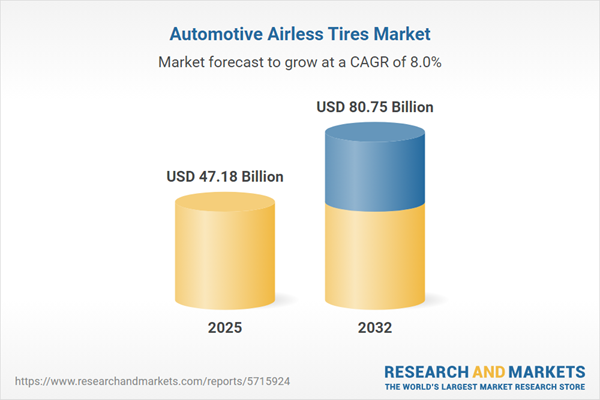Speak directly to the analyst to clarify any post sales queries you may have.
Senior leaders in the transport and logistics sector are increasingly viewing automotive airless tires as a strategic solution for increasing fleet reliability and simplifying maintenance. As operational complexity rises, these non-pneumatic tire technologies help organizations standardize processes, manage risk, and maintain consistent service levels in challenging environments.
Market Snapshot: Automotive Airless Tires Market Growth
The automotive airless tires market is demonstrating robust expansion, propelled by ongoing advances in both design and materials. With a compound annual growth rate of 7.98%, market value is increasing from USD 43.69 billion in 2024 to USD 47.18 billion in 2025, and projections extend to USD 80.75 billion by 2032. Growth is underpinned by the integration of modular tire designs, embedded digital monitoring, and versatile structural concepts that address commercial, industrial, and passenger fleet needs. Senior operations and procurement executives are leveraging these innovations to reduce operational risk, extend asset life cycles, and adapt to rapidly evolving industry expectations for performance and reliability.
Scope & Segmentation: Breadth of the Automotive Airless Tires Market
- Vehicle Types: Airless tire solutions are being specified for an extensive range of platforms, including passenger cars, commercial trucks, light utility vehicles, agricultural machinery such as tractors and harvesters, and various classes of industrial equipment. The adaptability of these tires extends to material-handling units and construction vehicles operating under rigorous conditions, meeting a diverse array of fleet requirements.
- Off-Road Segments: Equipment used in construction, mining, landscaping, and lawn care increasingly depends on airless tires to guarantee uninterrupted uptime and limit unplanned maintenance. The importance of this is most evident in critical project environments where delays have major financial and operational impacts.
- On-Road Segments: Logistics and transit operators apply airless tire technology to ensure steady vehicle performance, optimize cargo management, and enhance overall service reliability for passengers and freight under varying conditions.
- Geographic Coverage: The market’s international footprint includes the Americas, Europe, Middle East and Africa, and Asia-Pacific. Each region emphasizes distinct priorities: North America focuses on operational uptime, Europe stresses regulatory compliance and safety, and Asia-Pacific leads technology adoption and digital transformation. Localized needs often shape procurement and deployment strategies.
- Key Manufacturers: Notable industry participants such as Michelin, Bridgestone, Goodyear Tire & Rubber Company, Continental, Pirelli, Hankook Tire & Technology, Sumitomo Rubber Industries, and Resilient Technologies continue to pioneer manufacturing efficiencies and innovate with new materials, thereby addressing evolving requirements for commercial and industrial fleets.
- Technology Focus: Developments in modular spoke systems, thermoplastic elastomer compounds, and advanced sensor integration are bolstering tire durability and predictive maintenance capabilities. The use of 3D printing and laser sintering is supporting agile production, enhancing supply flexibility, and ensuring alignment with time-sensitive market needs.
Key Takeaways for Senior Decision-Makers
- Standardizing on automotive airless tires simplifies maintenance schedules and increases operational predictability, which helps minimize unscheduled interruptions in service.
- The pace of collaborative development is accelerating, with leading tire manufacturers, OEMs, and technology partners combining expertise to hasten product innovation and address varying operational requirements.
- Efforts to source locally and use recyclable materials support goals surrounding supply chain resilience and sustainability while simultaneously mitigating procurement risks for large fleets.
- Evolving compliance needs pose varied challenges, especially in geographically diverse enterprise operations where adapting to regulatory differences is essential for efficient service continuity.
- Enhanced fleet analytics and digital monitoring give organizations the insight needed to meet new compliance benchmarks and improve timely response to operational conditions across extended regions.
- Continuous research and structured product assessment processes are required to ensure environmental goals are met and that organizations achieve sustained advantages in a competitive market.
Tariff Impact: Navigating US Trade Policy Changes
Amid recent changes in US tire import tariffs and updates to tire component standards, enterprises are reevaluating procurement frameworks. The trend toward growing domestic manufacturing and increased collaboration with regional partners serves to reduce vulnerabilities stemming from global supply market disturbances, while aligning cost management and sustainability strategies.
Methodology & Data Sources
Insights for this market overview were gathered from in-depth interviews with manufacturing and logistics executives, technical patent reviews, and targeted stakeholder consultations. All findings have undergone thorough financial analysis and validation by independent white paper reviews to maintain objective accuracy and reliability.
Why This Report Matters
- Supports informed leadership decisions on modernization by outlining the regulatory changes and process challenges specific to the automotive airless tires market.
- Maps core sector dynamics and clarifies technology trends to help organizations direct investments and structure procurement strategies for measurable results.
- Delivers actionable recommendations that enable adaptive responses to ongoing policy shifts and the evolving demands of transport and logistics operations.
Conclusion
Automotive airless tire innovations are reshaping operational standards, enabling organizations to respond efficiently to shifting demands while maintaining high levels of fleet performance and resilience.
Additional Product Information:
- Purchase of this report includes 1 year online access with quarterly updates.
- This report can be updated on request. Please contact our Customer Experience team using the Ask a Question widget on our website.
Table of Contents
3. Executive Summary
4. Market Overview
7. Cumulative Impact of Artificial Intelligence 2025
Companies Mentioned
The companies profiled in this Automotive Airless Tires market report include:- Compagnie Générale des Établissements Michelin SCA
- Bridgestone Corporation
- The Goodyear Tire & Rubber Company
- Continental AG
- Pirelli & C. S.p.A.
- Hankook Tire & Technology Co., Ltd.
- Sumitomo Rubber Industries, Ltd.
- Resilient Technologies, Inc.
Table Information
| Report Attribute | Details |
|---|---|
| No. of Pages | 190 |
| Published | November 2025 |
| Forecast Period | 2025 - 2032 |
| Estimated Market Value ( USD | $ 47.18 Billion |
| Forecasted Market Value ( USD | $ 80.75 Billion |
| Compound Annual Growth Rate | 7.9% |
| Regions Covered | Global |
| No. of Companies Mentioned | 9 |









